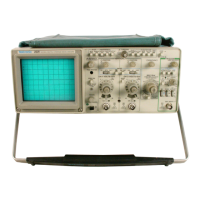iv i ensuring otgnais
it^
AVI
= 81. 0 *
TR
:g i =
B2* . AT = 17
2 .0 r
15
pT "
Si/
“ - r -
/ ir ~
\
XTw
|
s
"v
- _
- -
- ■
E
> 0.
5U
su
ERfiGE 5 ^ n s
Figure 3-38: Measuring Fail Time
CD Step 1: Apply a signal to the oscilloscope.
n Step 2: Set the trigger SLOPE out (positive) for a rise time measure
ment and in (negative) for a fall time measurement.
F I Step 3: Adjust the vertical dimension for exactly 5 divisions (you may
have to use the CAL variable.)
n Step 4: Vertically position the signal so that the bottom of the signal on
the 0% graticule line and the top of the signal is on the 100% line.
□ Step 5: Magnify the rising edge of the signal horizontally so that the rise
time is spread over 4 or 5 divisions. (Refer to Displaying Magnified
Sweeps, page 3-19.)
F I Step 6: Measure the rise time horizontally from the 10(%) graticule line
to the 90(%) graticule line,
Measuring Trigger Level
The trigger level is the point on the rising or falling edge of a signal where
the oscilloscope triggers a sweep. This voltage level is indicated by the TRIG
readout at the top of the CRT. TRIG1 represents the level of the trigger signal
coming from Channell and TRIG2 represents Channel 2.
Measuring Phase Difference
With the two vertical channels on the oscilloscope you can measure phase
differences on signals that range in frequency anywhere within the limits of
the vertical system. Use the following procedure;
f~l Step 1: Set both input coupling switches to the same position, depend
ing on the type of input coupling desired.
3-38
tn Detail

